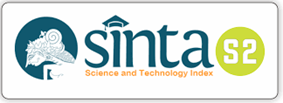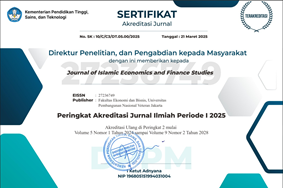NPF of Islamic Rural Banks in Indonesia: Do Socio-Economic Factors and Bank Performance Matter?
DOI:
https://doi.org/10.47700/jiefes.v5i2.10307Keywords:
Non PerForming Financing (NPF), Socioeconomic, Bank Characteristics, Financial Inclusion, BPRSAbstract
This study focuses on the analysis of socio-economic factors and bank characteristics that affect non-performing financing (NPF) in Islamic Rural Banks (BPRS) in Indonesia. The main problem raised is the high level of NPF which can threaten the financial stability of BPRS, even though financial inclusion continues to increase. The study uses the Panel Data Regression method, utilizing a sample of 139 BPRS registered with the Financial Services Authority (OJK) during the period 2015-2024. The results of the study show that economic inequality and operational efficiency have a significant effect on NPF, while the unemployment rate, GDP, and Financing to Deposit Ratio (FDR) do not show a significant effect. Capital Adequacy Ratio (CAR) and Return on Assets (ROA) are proven to have a significant impact on reducing the risk of non-performing financing. This finding emphasizes the importance of managing these variables to support the sustainability of BPRS in supporting financial inclusion and preventing the risk of bankruptcy.
Penelitian ini berfokus pada analisis faktor-faktor sosial ekonomi dan karakteristik bank yang memengaruhi pembiayaan bermasalah (Non-Performing Financing/NPF) pada Bank Pembiayaan Rakyat Syariah (BPRS) di Indonesia. Permasalahan utama yang diangkat adalah tingginya tingkat NPF yang dapat mengancam stabilitas keuangan BPRS, meskipun inklusi keuangan terus meningkat. Penelitian menggunakan metode Regresi Data Panel, dengan memanfaatkan sampel dari 139 BPRS yang terdaftar di Otoritas Jasa Keuangan (OJK) selama periode 2015-2024. Hasil penelitian menunjukkan bahwa ketimpangan ekonomi dan efisiensi operasional memiliki pengaruh signifikan terhadap NPF, sementara tingkat pengangguran, GDP, dan Financing to Deposit Ratio (FDR) tidak menunjukkan pengaruh signifikan. Capital Adequacy Ratio (CAR) dan Return on Assets (ROA) terbukti memiliki dampak signifikan dalam mengurangi risiko pembiayaan bermasalah. Temuan ini menegaskan pentingnya pengelolaan variabel-variabel tersebut untuk mendukung keberlanjutan BPRS dalam mendukung inklusi keuangan dan mencegah risiko kebangkrutan.
References
Ahmad, V. M., & Widodo, S. (2018). Analisis Pengaruh Gross Domestic Product (GDP), Inflasi, Financing Deposit Ratio (FDR), dan Kewajiban Penyediaan Modal Minimum (KPMM) Terhadap Non Performing Financing (NPF) pada Bank Umum Syariah di Indonesia Periode 2013-2017. Jurnal Sains Ekonomi Dan Perbankan Syariah, 8(1), 30–44.
Ahmed, H. A., & Shadmani, H. (2024). Income inequality, unemployment, and government transfer: what do their dynamics tell us. Journal of Economics and Development, 26(4), 274–289. https://doi.org/10.1108/JED-10-2023-0195
Akoijam, S. L. S. (2012). Rural credit: A source of sustainable livelihood of rural India. International Journal of Social Economics, 40(1), 83–97. https://doi.org/10.1108/03068291311283454
Alfian Akbar, D. (2016). Inflasi, Gross Domesctic Product (GDP), Capital Adequacy Ratio (CAR), Dan Finance To Deposit Ratio (FDR) Terhadap Non Performing Financing (NPF) Pada Bank Umum Syariah Di Indonesia. I-Economic, 2(2), 26–27.
Alissanda, D. G. (2015). Pengaruh Car, Bopo Dan Fdr Terhadap Non Performing Finance (Npf) Pada Bank Umum Syariah Tahun 2011-2013. In Jurnal Prosiding keuangan & Perbankan Syariah (Issue 2504, pp. 1–9). http://dx.doi.org/10.29313/syariah.v0i0.762
Ardana, Y. (2019). Faktor Internal, Makroekonomi dan Pembiayaan Bermasalah Bank Syariah di Indonesia. Esensi: Jurnal Bisnis Dan Manajemen, 9(1), 41–56. https://doi.org/10.15408/ess.v9i1.10743
Auliani, M. M., & Syaichu. (2016). Analisis Pengaruh Faktor Internal dan Faktor Eksternal Terhadap Tingkat Pembiayaan Bermasalah Pada Bank Umum Syariah di Indonesia Periode Tahun 2010-2014. Diponegoro Journal of Management, 5(3), 1–14. http://ejournal-s1.undip.ac.id/index.php/dbr
Bongomin, G. O. C., Munene, J. C., Ntayi, J. M., & Malinga, C. A. (2019). Collective action among rural poor: Does it enhance financial intermediation by banks for financial inclusion in developing economies? International Journal of Bank Marketing, 37(1), 20–43. https://doi.org/10.1108/IJBM-08-2017-0174
Devi, S., & Juniwati, H. (2024). Pengaruh Produk Domestik Bruto, Inflasi, dan Tingkat Pengangguran terhadap Non-Performing Financing pada BUS di Indonesia dengan Metode ARDL. Journal of Applied Islamic Economics and Finance, 4(3), 346–358. https://doi.org/10.35313/jaief.v4i3.6008
Elliyana, E., Bachtiar, I. H., Ramadani, D. P., & Rabia, A. B. (2020). Effect of Financing to Deposit Ratio (FDR) and of Financing To Asset Ratio (FAR) Against Non-Performing Financing (NPF) at the Branch Office of Bank Rakyat Indonesia Syariah Makassar. International Journal of Business Education and Management Studies (IJBEMS), 5(2), 178–186.
Fransiska, Y., & Siregar, P. A. (2023). The Analysis of Macroeconomic and Microeconomic Factors in Non-Performing Financing of Sharia Bank in Indonesia. Ekonomi, Keuangan, Investasi Dan Syariah (EKUITAS), 4(4), 1128–1136. https://doi.org/10.47065/ekuitas.v4i4.3250
Ginting, A. M. (2017). Pengaruh Makroekonomi Terhadap Non Performing Loan (Npl) Di Indonesia: Studi Non Performing Loan Perbankan. Jurnal Ekonomi Dan Kebijakan Publik, 7(2), 159. https://doi.org/10.22212/jekp.v7i2.669
Hamda, I., & Nurasri Sudarmawan, B. (2023). Capital, Efficiency, Management Risk on Islamic Bank Stability During Covid-19 PandemiC. Tazkia Islamic Finance and Business Review, 17(1), 36–55. https://doi.org/10.30993/tifbr.v17i1.309
Hapsari, P. N., & Widarjono, A. (2023). Diversifikasi pembiayaan dan pengaruh Covid-19 terhadap Non Performing Financing (NPF) di Provinsi Jawa Barat Indonesia. Jurnal Kebijakan Ekonomi Dan Keuangan, 2(1), 36–49. https://doi.org/10.20885/jkek.vol2.iss1.art5
Heny Purwaningtyas, U. H. (2020). pengaruh GDP, INFLASI, KURS, CAR, FDR, FINANCING BANK SIZE TERHADAP NPF PERBANKAN SYARIAH DI INDONESIA TAHUN 2014-2017. Jurnal Ilmu Manajemen (JIM), 8(21), 352–367.
Hidayah, A. N., & Meylianingrum, K. (2024). Macroeconomic Impact on Non-Performing Financing in Islamic Banking in 2011-2021. Al-Intaj : Jurnal Ekonomi Dan Perbankan Syariah, 9(2), 280. https://doi.org/10.29300/aij.v9i2.2461
Hosen, M. N., & Muhari, S. (2019). Non-performing financing of Islamic rural bank industry in Indonesia. Banks and Bank Systems, 14(1), 20–28. https://doi.org/10.21511/bbs.14(1).2019.03
Isnaini, L., Haryono, S., & Muhdir, I. (2021). Pengaruh ROA, CAR, BOPO, FDR, Dan Inflasi Terhadap Pembiayaan Bermasalah (NPF) Di Bank Umum Syariah. JPEK (Jurnal Pendidikan Ekonomi Dan Kewirausahaan), 5(1), 65–75. https://doi.org/10.29408/jpek.v5i1.3095
Khoiriyah, D. N., & Amalia, F. (2023). Dampak inklusi dan literasi keuangan terhadap ketimpangan pendapatan melalui kredit UMKM di Indonesia tahun 2016 dan 2019. Jurnal Riset Ekonomi Dan Bisnis, 16(1), 16. https://doi.org/10.26623/jreb.v16i1.6303
Kuncoro, M. (2019). Ekonomika regional: teori dan aplikasi. Rajawali Press: Jakarta.
Kusuma, M., Narulitasari, D., & Nurohman, Y. A. (2022). Inklusi Keuangan Dan Literasi Keuangan Terhadap Kinerja Dan Keberlanjutan Umkm Disolo Raya. Among Makarti, 14(2).
Lal, T. (2019). Measuring impact of financial inclusion on rural development through cooperatives. International Journal of Social Economics, 46(3), 352–376. https://doi.org/10.1108/IJSE-02-2018-0057
Lusiana, E. D., Pramoedyo, H., & Sudarmawan, B. N. (2022). Spatial Quantile Autoregressive Model: Case Study of Income Inequality in Indonesia. Sains Malaysiana, 51(11), 3795–3806. https://doi.org/10.17576/jsm-2022-5111-23
Miranti, T., & Oktaviana, U. K. (2022). Effect of Capital Structure on Financial Sustainability of Sharia Public Financing Bank (BPRS). Ad-Deenar: Jurnal Ekonomi Dan Bisnis Islam, 6(01), 137. https://doi.org/10.30868/ad.v6i01.2301
Muhammad, R., Suluki, A., & Nugraheni, P. (2020). Internal factors and non-performing financing in Indonesian Islamic rural banks. Cogent Business and Management, 7(1). https://doi.org/10.1080/23311975.2020.1823583
Nindita, D. R. (2015). KETERKAITAN INFLASI, SUKU BUNGA KREDIT, DAN TINGKAT PENGANGGURAN TERHADAP KREDIT BERMASALAH PADA BANK UMUM DI INDONESIA. Jurnal Ilmiah Mahasiswa FEB, Vol. 3 No. 2, 19.
Nugrohowati, R. N. I., & Bimo, S. (2019). Analisis pengaruh faktor internal bank dan eksternal terhadap Non-Performing Financing (NPF) pada Bank Perkreditan Rakyat Syariah di Indonesia. Jurnal Ekonomi & Keuangan Islam, 5(1), 42–49. https://doi.org/10.20885/jeki.vol5.iss1.art6
Nur’aisyah, I., Dora, L. S., Kholishoh, & Aziz, A. (2020). Peran Bank Pembiayaan Rakyat Syariah (Bprs) Dalam Pengembangan Umkm Di Indonesia. INKLUSIF : Jurnal Pengkajian Penelitian Ekonomi Dan Hukum Islam, 5(2), 114–126. www.syekhnurjati.ac.id/jurnal/index.php/inklusif
Papadopoulos, G. (2019). Income inequality, consumption, credit and credit risk in a data-driven agent-based model. Journal of Economic Dynamics and Control, 104, 39–73. https://doi.org/10.1016/j.jedc.2019.05.002
Priyadi, U., Utami, K. D. S., Muhammad, R., & Nugraheni, P. (2021). Determinants of credit risk of Indonesian Sharīʿah rural banks. ISRA International Journal of Islamic Finance, 13(3), 284–301. https://doi.org/10.1108/IJIF-09-2019-0134
Putri, L. T., & Sudarmawan, B. N. (2023). MACROECONOMIC OUTLOOK AND BANK STABILITY : THE CASE OF.
Rifa’i, A. (2017). The Role of Islamic People’s Financing Banks in Implementing Inclusive Finance Through MSME Financing. Human Falah, 4(2), 194–217.
Shihadeh, F., & Liu, B. (2019). Does financial inclusion influence the banks risk and performance? Evidence from global prospects. Academy of Accounting and Financial Studies Journal, 23(3).
Soekapdjo, S., & Tribudhi, D. A. (2020). Pengaruh faktor eksternal dan internal terhadap kredit bermasalah perbankan konvensional di indonesia. Kinerja, 17(2), 278–286.
Sri Hartati, Y. (2021). Analisis Pertumbuhan Ekonomi Inklusif Di Indonesia. Jurnal Ekonomi Dan Bisnis, 12(1), 79–92. https://doi.org/10.55049/jeb.v12i1.74
Sudarsono, H. (2018). ANALISIS PENGARUH VARIABEL MIKRO dan MAKRO TERHADAP NPF PERBANKAN SYARIAH di INDONESIA. Equilibrium: Jurnal Ekonomi Syariah, 6(1), 1. https://doi.org/10.21043/equilibrium.v6i1.3040
Wahyudin, M. W., Novianty, I., & Burhany, D. I. (2020). The Effect of Economic Condition and Banking Policy on Non-Performing Financing and Profitability: Evidence from Islamic Rural Banks in Indonesia. 198(Issat), 545–551. https://doi.org/10.2991/aer.k.201221.090
Wahyuni, A. S., Hadiani, F., Laksana, B., & Barnas, B. (2023). Pengaruh Faktor Makroekonomi dan Faktor Spesifik Bank terhadap NPF Bank Umum Syariah di Indonesia. Journal of Applied Islamic Economics and Finance, 3(2), 216–224. https://doi.org/10.35313/jaief.v3i2.3729
Wibowo, S. A., & Saputra, W. (2017). Pengaruh Variabel Makro Dan Mikro Ekonomi Terhadap Pembiayaan Bermasalah Pada Bank Syariah Di Indonesia. Jurnal Ilmiah Akuntansi, 2(1), 96–112. https://doi.org/10.23887/jia.v2i1.10040
Widyawati, G. N., & Djazari, M. (2017). Pengaruh Capital Adequacy Ratio (CAR), Non Performing Financing (NPF), Operational Efficiency Ratio (OER), Penyisihan Penghapusan Aktiva Produktif (PPAP) Dan Net Operating Margin (NOM) Terhadap Profitabilitas Pada Bank Umum Syariah Periode 2010-2015. Jurnal Profita, 2(1), 1–12.
Yolanda, S., & Ariusni, A. (2019). Pengaruh Faktor Internal Dan Eksternal Terhadap Pembiayaan Bermasalah Pada Bank Umum Syariah (Bus) Dan Bank Pembiayaan Rakyat Syariah (Bprs). Jurnal Kajian Ekonomi Dan Pembangunan, 1(3), 833. https://doi.org/10.24036/jkep.v1i3.7710
Downloads
Published
Issue
Section
License
Copyright (c) 2025 Rifky Zahrul Aprilian, Barianto Nurasri Sudarmawan

This work is licensed under a Creative Commons Attribution 4.0 International License.
Authors who publish with this journal agree to the following terms:
- Authors retain copyright and grant the journal right of first publication with the work simultaneously licensed under a Creative Commons Attribution 4.0 International License that allows others to share the work with an acknowledgment of the work's authorship and initial publication in this journal.
- Authors can enter into separate, additional contractual arrangements for the non-exclusive distribution of the journal's published version of the work (e.g., post it to an institutional repository or publish it in a book), with an acknowledgment of its initial publication in this journal.
- Authors are permitted and encouraged to post their work online (e.g., in institutional repositories or on their website) before and during the submission process, as it can lead to productive exchanges, as well as earlier and greater citation of published work.

This work is licensed under a Creative Commons Attribution 4.0 International License.











